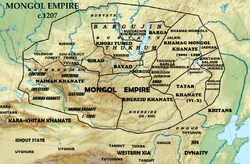
Back الكيرايت Arabic Кераити Bulgarian Kerait Catalan Keraiten German Kerajtoj Esperanto Keraitas Spanish Kereiidid Estonian کرائیتها Persian Kereiitit Finnish Kéraït French
This article needs additional citations for verification. (March 2020) |
Keraites Хэрэйд (Khereid) | |||||||||||
|---|---|---|---|---|---|---|---|---|---|---|---|
| 11th century–13th century | |||||||||||
 | |||||||||||
| Status | Subjects to: Liao dynasty, Qara Khitai (Western Liao), Genghisids | ||||||||||
| Religion | Church of the East | ||||||||||
| Government | Khanate | ||||||||||
| Khan | |||||||||||
• 11th century | Markus Buyruk Khan | ||||||||||
• 12th century | Saryk Khan | ||||||||||
• 12th century | Kurchakus Buyruk Khan | ||||||||||
• –1203 | Toghrul Khan (last) | ||||||||||
| Historical era | Middle Ages | ||||||||||
• Established | 11th century | ||||||||||
• absorbed into the Mongol Empire. | 13th century | ||||||||||
| |||||||||||
| Today part of | Khalkha Mongols,[1][2] Buryats,[3][4] Kalmyks[5] and some other Mongol and Turkic peoples | ||||||||||
The Keraites (also Kerait, Kereit, Khereid; Mongolian: Хэрэйд; Chinese: 克烈) were one of the five dominant Turco-Mongol tribal confederations (khanates) in the Altai-Sayan region during the 12th century. They had converted to the Church of the East (Nestorianism) in the early 11th century and are one of the possible sources of the European Prester John legend.
Their original territory was expansive, corresponding to much of what is now Mongolia. Vasily Bartold (1913) located them along the upper Onon and Kherlen rivers and along the Tuul river.[6] They were defeated by Genghis Khan in 1203 and became influential in the rise of the Mongol Empire, and were gradually absorbed into the succeeding Mongol khanates during the 13th century.
- ^ Үндэсний Статистикийн Хороо. Хэрээд.
- ^ Үндэсний Статистикийн Хороо. Хэрэйд.
- ^ Нанзатов Б. З. Кударинские буряты в XIX веке: этнический состав и расселение // Вестник БНЦ СО РАН. — 2016. — № 4 (24). — С. 126—134.
- ^ Нанзатов Б. З., Содномпилова М. М. Селенгинские буряты в XIX в.: этнический состав и расселение (юго-западный ареал) // Вестник БНЦ СО РАН. — 2019. — № 1 (33). — С. 126—134.
- ^ Бембеев В. Ойраты. Ойрат-калмыки. Калмыки: история, культура, расселение, общественный строй до образования Калмыцкого ханства в Поволжье и Предкавказье. — Джангар, 2004. — С. 87. — 495 с.
- ^ V.V. Bartold in the article on Genghis Khan in the 1st edition of the Encyclopedia of Islam (1913); see Dunlop (1944:277)